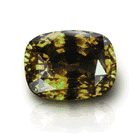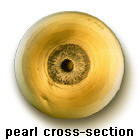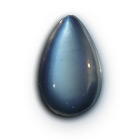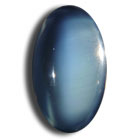ALEXANDRITE
JUNE BIRTHSTONE
 This
rare gemstone is named after the Russian tsar Alexander II (1818-1881), the
very first crystals having been discovered in April 1834 in the emerald
mines near the Tokovaya River in the Urals. The discovery was made on the
day the future tsar came of age. Although alexandrite is a relatively young
gemstone, it certainly has a noble history. Since it shows both red and
green, the principal colors of old Imperial Russia, it inevitably became the
national stone of tsarist Russia.
This
rare gemstone is named after the Russian tsar Alexander II (1818-1881), the
very first crystals having been discovered in April 1834 in the emerald
mines near the Tokovaya River in the Urals. The discovery was made on the
day the future tsar came of age. Although alexandrite is a relatively young
gemstone, it certainly has a noble history. Since it shows both red and
green, the principal colors of old Imperial Russia, it inevitably became the
national stone of tsarist Russia.
Beautiful alexandrite in top quality, however, is very rare indeed and
hardly ever used in modern jewelry. In antique Russian jewelry you may come
across it with a little luck, since Russian master jewelers loved this
stone. Tiffany’s master gemologist George Frederick Kunz (1856-1932) was
also fascinated by alexandrite, and the jeweler's firm produced some
beautiful series of rings and platinum ensembles at the end of the 19th and
beginning of the 20th century. Smaller alexandrites were occasionally also
used in Victorian jewelry from England.
The magic of changing colors
The most sensational feature about this stone, however, is its surprising
ability to change its colors. Green or bluish-green in daylight, alexandrite
turns a soft shade of red, purplish-red or raspberry red in incandescent
light. This unique optical characteristic makes it one of the most valuable
gemstones of all, especially in fine qualities.
Alexandrite is very scarce: this is due to its chemical composition. It is
basically a chrysoberyl, a mineral consisting of colorless or yellow
transparent chrysoberyl, chrysoberyl cat’s eye and color-changing
alexandrite (also in cat’s eye varieties). It differs from other chrysoberyl
in that it not only contains iron and titanium, but also chromium as a major
impurity. And it is this very element which accounts for the spectacular
color change. Rarely, vanadium may also play a part. According to CIBJO
nomenclature, only chrysoberyl displaying a distinct change of color may be
termed alexandrite.
Like many other gemstones, alexandrite emerged millions of years ago in a
metamorphic environment. But unlike many others, its formation required
specific geological conditions. The chemical elements beryllium (a major
constituent in chrysoberyl) and chromium (the coloring agent in alexandrite)
have contrasting chemical characteristics and do not as a rule occur
together, usually being found in contrasting rock types. Not only has Nature
brought these contrasting rock types into contact with each other, but a
lack of the chemical element silica (the second most common element in the
Earth's crust) is also required to prevent the growth of emerald. This
geological scenario has occurred only rarely in the Earth's history and, as
a result, alexandrite crystals are very scarce indeed.
Nowadays not only from Russia
 Russia
has remained the primary source of alexandrite since gems from the mines of
the Urals became available on the market. When the Russian deposits were
thought to have been exhausted, interest in the unique color miracle
decreased - especially since alexandrites from other mines hardly ever
displayed the coveted color change - . But the situation changed
dramatically in 1987, when alexandrites were discovered in a place called
Hematita in Minas Gerais, Brazil. The Brazilian alexandrites showed both a
distinctive color change and good clarity and color. Thus the somewhat
dulled image of the miraculous stone received another boost. The color of
the Brazilian stones is admittedly not as strong a green as that of Russian
alexandrite, but the color change is clearly discernible. Today Hematita is
one of the most important deposits of alexandrite in economic terms.
Occasionally alexandrite with chatoyancy is discovered there, an effect
which has not yet been observed in Russian alexandrite. Alexandrites are
also recovered from sources in Sri Lanka, but the hue of these stones
compares less than favorably with that of the Uralian alexandrites. They
appear green in daylight and a brownish red in artificial light. The Tunduru
area in southern Tanzania has also produced some outstanding specimens since
the mid-1990’s. Alexandrites are also found in India, Burma, Madagascar and
Zimbabwe. Although this stone is still considered a rarity, specialized
gemstone dealers do stock it, especially since improved trade relationships
between Russia and the rest of the world have ensured a better supply of
Russian alexandrites to the market.
Russia
has remained the primary source of alexandrite since gems from the mines of
the Urals became available on the market. When the Russian deposits were
thought to have been exhausted, interest in the unique color miracle
decreased - especially since alexandrites from other mines hardly ever
displayed the coveted color change - . But the situation changed
dramatically in 1987, when alexandrites were discovered in a place called
Hematita in Minas Gerais, Brazil. The Brazilian alexandrites showed both a
distinctive color change and good clarity and color. Thus the somewhat
dulled image of the miraculous stone received another boost. The color of
the Brazilian stones is admittedly not as strong a green as that of Russian
alexandrite, but the color change is clearly discernible. Today Hematita is
one of the most important deposits of alexandrite in economic terms.
Occasionally alexandrite with chatoyancy is discovered there, an effect
which has not yet been observed in Russian alexandrite. Alexandrites are
also recovered from sources in Sri Lanka, but the hue of these stones
compares less than favorably with that of the Uralian alexandrites. They
appear green in daylight and a brownish red in artificial light. The Tunduru
area in southern Tanzania has also produced some outstanding specimens since
the mid-1990’s. Alexandrites are also found in India, Burma, Madagascar and
Zimbabwe. Although this stone is still considered a rarity, specialized
gemstone dealers do stock it, especially since improved trade relationships
between Russia and the rest of the world have ensured a better supply of
Russian alexandrites to the market.
A gemstone for experts and gemstone
lovers
With its good hardness of 81/2, alexandrite is an uncomplicated stone to
wear. The more distinct the change of color, the more valuable the stone. A
fine alexandrite should show a vivid bluish-green in daylight and a
purplish-red in artificial light, without any trace of undesirable brown or
grey. If the origin of the stone is known beyond dispute to be Russia, we
are talking about a real rarity of enormous value. Finely faceted
alexandrites above one carat are thus among the most expensive gemstones in
the world, rarer than fine ruby, sapphire or emerald.
Alexandrite is a stone for experts, enthusiasts and connoisseurs, a true
understatement stone. Its uniqueness and high value are not evident at first
sight. The mysterious color change will only occur on exposure to different
light sources. But if you really get involved in alexandrite, you will be
utterly fascinated by this gem. Maybe you will also feel some of the
mysterious magic and lore ascribed to it. It is considered a stone of very
good omen. In critical situations it is supposed to strengthen the wearer’s
intuition, and thus help him or her find new ways forward in situations
where logic will not provide an answer. Alexandrite is also reputed to aid
creativity and inspire imagination.
 Pearls are an
organic gem, created when an oyster covers a foreign object with beautiful
layers of nacre. Long ago, pearls were important financial assets, comparable in
price to real estate, as thousands of oysters had to be searched for only one
pearl. They were rare because they were created only by chance.
Pearls are an
organic gem, created when an oyster covers a foreign object with beautiful
layers of nacre. Long ago, pearls were important financial assets, comparable in
price to real estate, as thousands of oysters had to be searched for only one
pearl. They were rare because they were created only by chance.

